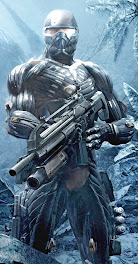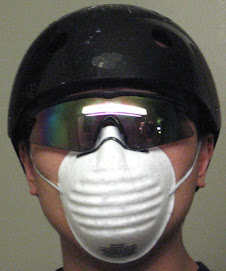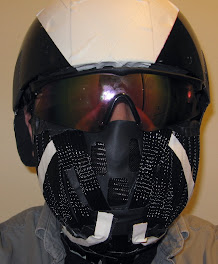


I made a rough mock up of what the helmet might look like with black and white gaffer's tape. Looking at the stark contrast between the two colors, I think I'll have to do the silver parts of the suit in a dark gray instead of white or silver, because I think there's too much contrast here for a military suit of armor.
Thursday, February 28, 2008
Day 4 - Helmet Mock Up
Wednesday, February 27, 2008
Day 3 - Speaking of Comfort...
:) Just kidding. If I have time later tonight, I will try to work on the helmet some more.
Edit: I found a pair of boots that look close enough to combat boots at a thrift store down the street from work during my lunch break. I'll post pics when I get home tonight.

Tuesday, February 26, 2008
Day 2 - Armor Sample

Monday, February 25, 2008
Day 1 - Part Deux


I made a slight modification to the helmet. I pried off the chin straps (they were riveted to the helmet) since the shell seemed to stay on my head just fine with the new padding, even with moderate head-shaking. I almost definitely need to remove the lenses entirely and fabricate a whole new housing for them. Simply put: my head's too big for them. Too wide, to be precise. Even if I take off the arms or whatever you call them, the frame holding the lenses (is this still plural if it's in one piece?) curves in too sharply to properly go around my face, so they'll have to go. I'm figuring I might need to either use clay to get the exact shape I want or start with clay to use as a mold for something else. Anyone have any suggestions? I might try some of the materials found in this tutorial.
From these two views, you can see that the mouth/face mask isn't wide enough to cover my cheeks like it should, and it sticks out too far past my nose (the reference photos seem to indicate it's about even with the tip of my nose. But as I say, it's a start and merely a platform for building the real thing.
I have a scrap of test armor where I sewed some of the braided sleeving to a piece of gaffer's tape to see how it would look side-by-side like it would on the finished product. But I think I left my red folder that I keep small test items like that and some extra reference photos at work, so I'll have to post pictures of that another day, probably tomorrow.
Day 1 - Reference Photos Collage

As promised, here is my collection of reference photos. Go ahead, shudder at my neurosis. Just to put it into perspective, it's 4' x 4'. The things sticking out at the bottom are the arms of the chair I propped this on.
Day 1 - Gotta Start Somewhere
At the behest of my wife, I'm starting a blog about my trials and tribulations in creating my nanosuit costume from the PC game Crysis. For those of you not familiar with the game, go to nanosuit.com for more info on the game itself. This blog will cover not only the creation of the costume itself, but also any cool related tidbits I've discovered and researched along the way (and as you can tell from the links, I'm quite the fan of Wikipedia).
Since I've already started the project, this first blog will be far longer than any subsequent ones. And I can't really call this Day 1, but just for the sake of argument, we'll go with that. I probably won't even be counting the days anyway from this point forward, but meh, we'll see how it goes. Now, without any further ado...
My first step in starting any of my costumes, especially my more complicated ones like this one, is gathering as much reference photos as possible. Much thanks go to gamespot.com and incrysis.com where I got most of my hi-res pictures I'm using. I started out keeping the printouts in a folder I carried around with me, but after collecting quite a few, they became rather cumbersome to flip through, so I decided to paste them to a giant 4'x4' piece of cardboard. If you just glanced at it from a distance, you'd think I was a crazy stalker (is there any other kind?) with the number of photos pasted on that board. I'll post a picture of it when I get home. I finished it around 1am last night, because I promised my wife I'd clean up after myself when I was done. Cleaning it up at an earlier time before it was done would have been pointless since I would have to unpack it and make a mess again when I go to finish the job.
Before I even compiled my reference photos into a collage, I started researching possible materials for the suit's armor. My ultimate goal is that I wanted the costume to be as comfortable, functional, and real as possible. (Speaking of comfort, this old costume from Half Life 2 wasn't too comfortable sitting down. Standing and walking was fine though, but it got hot fast and it was delicate.) Obviously, I don't have the means to make the suit inject nano molecules into my bloodstream for Maximum Strength or make itself turn invisible with a cloaking feature, but I was hoping at least to make a semi-viable liquid armor which is currently in development today using non-newtonian fluids.
In a nutshell, these fluids change viscosity (how easily they flow) depending on the forces applied to them. Some flow easier with more force applied (like how paint flows easily when stirred but flows slowly when applied to a wall) while others, shear thickening fluids, behave the opposite: they flow slower the more force is applied to them, even to the point of behaving like a solid.
You can even make some yourself at home with a mixture commonly called oobleck (2 parts corn starch and 1 part water by volume). Once it's evenly mixed in a bowl, you can even punch it and it won't splash or even budge. If you let your fingers slowly sink into it and then quickly rake it across, you can see the oobleck breaking apart momentarily like clay, then become liquid again and ooze back to fill in the cracks. Check out this Youtube video of some guys running across a pool of the stuff!
Obviously, the military won't be using cornstarch and water to be protecting our troops in the field. Instead, they are using silica powder (ultra-fine sand) and polyethylene glycol (PEG) in place of corn starch and water, respectively. In a nutshell, they soak layers of kevlar fabric in the stuff, squeeze out the excess in rollers, and let them dry. Once done, they can make kevlar armor that is 20-25% thinner (fewer layers) and still have the same if not better stopping power than kevlar alone. Very cool. You know what's even more cool? You can buy silica powder and PEG yourself online. It's somewhat expensive, but not insanely so. Seeing as how my funds are somewhat limited, you folks will have to test out your own home-brew military-grade liquid armor. ;)
Now back to the costume (after quite an extended tangent). I decided to test out oobleck armor by cutting short lengths of an old bicycle tube and filling it with oobleck. I sealed it up by rolling up the ends and taping it shut (sewing it would have been silly since it would ooze out the needle holes, and I didn't want to glue it because this was a test that would probably need further non-permanent adjustments). In theory, this should work nicely since the actual armor is composed of pieces very reminiscent to bundles of muscle fibers, and I can arrange these tubes in a pattern to match the armor. I made a few of these, and taped them side-by-side to simulate one of the chest pieces. Now the test: I held it up against a wall and punched it. :) Obviously, I didn't start off hitting it as hard as I could, but I eventually worked myself up hitting harder and harder each time. By the end, my knuckles were turning red, but no pain from punching the wall! Yay! Now the bad news: I hefted my collection of oobleck armor tubes and estimated that the final armor would be WAY too heavy to be comfortable. Oh well, it was fun playing with the oobleck anyway, and it only cost me a box of cornstarch which we use for cooking anyway, so no big loss.Even when I was still playing with the idea of using bike tire tubes for armor, it still didn't have the texture of the nanosuit armor I was looking for, so even if the oobleck armor worked out, it would still need to be covered with something to give it the right look. After a little brainstorming, I came upon the idea of using expandable braided sleeving used for organizing cables. The braiding pattern would look nice, it's flexible, and it will conform to different shapes (with limits) so it seems like the perfect material for muscle-like flexible armor. It's not too expensive here at $.50/ft for a bulk roll of 3/4" x 75' or more. If anyone finds a better deal, let me know! I'm not sure how much I'll ultimately need, but as a rough estimate, I measured myself to figure out how much surface area I have on my body (diameters of my torso, arms, and legs times their respective lengths) and figured I would need approximately 350' of this stuff. Obviously, it won't be exact, because there are smaller widths used in some areas, the mouth/cheek area for example. As for color, I decided on black. I know the actual armor is more of a graphite/dark gray, but I figure black will be easier to work with in terms of matching colors with everything else. I didn't want the costume to be a mish-mash of different shades of gray because I couldn't match the colors exactly, and black is easily matched and accessible (and cheaper!).
I've started work on the helmet. Due to what seems to be the size and shape of the helmet (somewhat form-fitting), I bought a used child's skateboarding helmet and gutted the foam padding inside. With just the outer shell, it was just a little bit bigger than my adult-sized head, so I re-padded it. Since I don't need this helmet to protect me from any actual head injuries (yeah, I know it's stepping away from my goal of real/functional armor. So sue me), I replaced the hard foam with layers of soft craft foam glued together (follow the link for the tutorial I used to make my Half Life 2 costume). Doing it in layers allows me to fine-tune the fit so it's just right for my head. For the goggles, I'm starting off with a pair of safety glasses I bought from Sears for 8 bucks. My original idea was to modify ski/snowboard goggles, since they already have the st
rap attached, but I couldn't find any that were just the right shape and most were too expensive. They also didn't have the reflective coating I was looking for, so I went with the safety glasses. I plan on taking them apart, either entirely so I can get at the lenses, or just taking off the side parts and attaching the new custom frame I'll have to make. For the face mask, I bought safety masks to use as a basic shape from which to make the actual face mask. In actuality, they stick out much too far from my face, but it gives me a starting point from which to work from. Plus, I need to design a way for me to breath easily without fogging up the glasses, because that's what's happening with this temporary setup I have now.
So...after much blabbing, that's where I'm currently at for Day 1 (whew, I'm tired. That was a log of work for just one day, lol). As far as my plans for the costume, I'm going to order a spandex/lycra bodysuit (with the face cut out) as a base layer from which to attach all the armor pieces. I want to attach a bluetooth headset to the helmet so I can talk on the phone. I haven't decided whether I'll keep the phone in a hip pouch or attach it to my wrist as a pseudo wrist display/computer. I also want to attach a walkie-talkie headset for the same reason for my FRS set I have. For the Push-to-Talk (PTT) button, I'll wire that somewhere down to my hand. I expect this suit might get pretty hot, so I'm going to see if I can fix the fan for my portable car fridge and install the guts of that somewhere on the suit. Probably on my back. I'm going to install some red LEDs for the lights scattered throughout the suit (I believe they're for cloaking in the game). For any wiring I have to do, I'm going to run them through the braided sleeving conveniently laid out everywhere on the suit. The batteries to run everything will be mounted in those hip pouches.
I'm not sure yet what I'll use for the white/silver armor pieces on the suit. I have a few ideas I'll try out, but we'll cross that bridge when we get there. Till next time!






